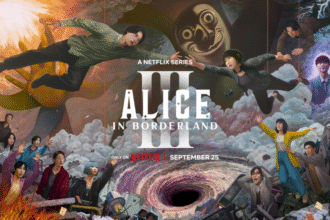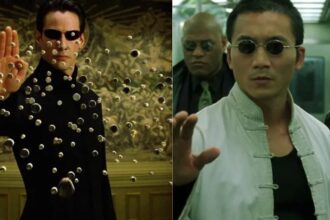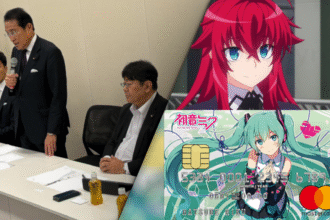
The climax of The Matrix builds toward Neo’s decision to stop running from who he is. Until now, Neo, born as Thomas Anderson, has constantly doubted whether he truly holds the title of The One.
His arc is marked by hesitation, self-questioning, and a back-and-forth struggle between believing what Morpheus told him and what the simulated world shows him. The ending pushes Neo into a moment where he must face a life-or-death choice that can only be answered by embracing his destiny.
This transformation starts after the team’s mission into the Matrix goes tragically wrong. Morpheus is taken captive by Agent Smith, leaving Neo and Trinity to mount a desperate rescue.
During this moment, Neo’s courage is tested, and unlike earlier in the film, where he hesitated under pressure, this time he attacks the situation with clarity and fearless determination. It’s not just about saving Morpheus; it is Neo’s first step toward accepting that he has the agency to bend the rules of the Matrix.
The true climax arrives when Neo confronts the agents directly. Normally, agents were considered unstoppable, nearly invincible entities within the computer simulation. Morpheus had even said that all men who had stood their ground against them had died.
Yet Neo holds his position, not just running or escaping, but directly fighting against what Morpheus earlier described as their inevitable superiority. Each strike, each move in the battle, becomes symbolic of Neo’s transformation.
Then comes the pivotal resurrection scene. After a desperate escape sequence, Neo is gunned down by Agent Smith, and the cold reality points to his death. But in parallel, Trinity, in the real world, whispers her belief that he is The One. This faith acts as a key moment: the love and trust of his companions blend into Neo’s resolve.
He is reborn, not in the physical sense, but as the true One who can rewrite the rules of the Matrix. His eyes open with a new kind of perception: suddenly, walls, bullets, and agents themselves become streams of green code. For Neo, reality inside the simulation shifts from illusion into raw information that can be controlled.
At this point, Neo does not just participate within the Matrix; he redefines it. He stops bullets effortlessly with a raised hand, bends physics as he sees fit, and fights Agent Smith without strain.
The impossible becomes casual. This moment is perhaps one of the defining scenes in cinema: the underdog becomes a transcendent figure, shifting from a doubting fugitive into the savior prophesized all along.
Also Read: Turning Red Ending Explained, Embracing Every Part of Yourself
The Symbolism of Neo’s Acceptance and What It Means
The ending of The Matrix is loaded with symbolism. Neo’s death and resurrection mirror mythological and religious figures, particularly those rooted in themes of sacrifice, rebirth, and divine power. His journey echoes the archetype of the reluctant hero who accepts greatness only when pushed to the edge.
When Neo sees the world as code, it signifies the power of perception. Humanity is shown to be trapped not only physically but also mentally by the rules designed within the Matrix.
The agents rely on fear and inevitability to control humans, convincing them that resistance is futile. Neo breaks this illusion, proving that liberation begins in the mind. His newfound clarity demonstrates that the system, no matter how elaborate, still has vulnerabilities.
The love between Trinity and Neo also holds deep weight in this transition. While the prophecy speaks of The One, it is Trinity’s belief that anchors him when he nearly succumbs to death.
The message woven throughout is that hope, trust, and human connection provide the strength to push beyond what seems predetermined. Their bond is not just romantic storytelling but rather the representation of how collective faith in a cause can spark revolution.
Another symbolic layer lies in how the agents respond during Neo’s rebirth. Their expressions change. What was once absolute dominance shifts into visible uncertainty. These machines, modeled as cold and logical, suddenly encounter the concept of unpredictability.
Neo’s existence as The One represents not only a triumph of humanity’s willpower but also the proof that no system, however strict, can perfectly control freedom of thought.
Finally, the closing phone call Neo makes within the Matrix cements his role. He speaks directly against the machine overlords, sending a warning that he is no longer simply surviving under their power.
He promises to open the eyes of others, to show humanity the same truth he has seen. His words, paired with his final ascent into the sky, symbolize liberation and limitless possibility. This is less a finality and more a beginning, setting the stage for the larger conflict between man and machine.
Why the Ending Resonates as a Cultural Touchstone
The ending of The Matrix has remained consistently relevant because it seamlessly intertwines action spectacle with deeply philosophical ideas. On the surface, it’s an exhilarating finale loaded with groundbreaking special effects: bullet time, gravity-defying martial arts, and Neo’s now-iconic flight. But beneath the thrills lies a meditation on control, freedom, and self-realization.

The significance of Neo’s journey lies in its resonance with anyone who has ever questioned whether they are trapped by rules, institutions, or expectations that seem unbreakable.
Neo represents the ultimate dream of breaking free. The film’s popularity can largely be attributed to this notion of truth-seeking, showing that perceived boundaries are often illusions designed to keep order intact.
From a storytelling perspective, the ending also spoke to a turn-of-the-millennium audience living in an age where technological optimism and anxiety coexisted.
The Matrix, as a concept, channeled fears about all-encompassing systems, artificial intelligence, and the loss of individual freedom. By ending on Neo’s newfound power, the film didn’t just give a satisfying conclusion; it provided hope that resistance is always possible.
Furthermore, the ending redefined how Hollywood portrayed the hero’s journey. Instead of relying on conventional realism, it rewrote visual rules to emphasize that reality itself can be questioned. This inventive world-building pushed audiences to think critically about technology, control, and free will, sparking cultural discussions that lasted well beyond the film’s release.
The key reason the ending endures is its balance of spectacle and philosophy. Neo flying into the sky in the final moments is entertaining, but it is also metaphorical: it’s about transcending limits. Each viewer can see it as either a sci-fi fantasy or an allegory of human empowerment. This dual quality keeps the finale relevant across generations of moviegoers.
Also Read: Moana Ending Explained, Restoring the Heart of Te Fiti








